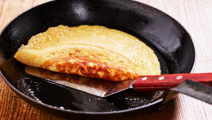
French omelette

Instructions
Recommended information
Serving suggestion
French omelette
Nutritional values
Nutritional value, per
892 Kcal
| Fibre | 7 gram fibers |
| Protein | 61.3 |
| Carbohydrates | 14.4 |
| Fat | 66.1 gram |
Ingredients
Omelette
Eggs | 8 |
|---|---|
Milk | 100 ml |
Salt | 1 tsp |
Butter | 1 tbsp |
Filling
Fresh mushrooms | 250 g |
|---|---|
Garlic clove | 1 |
Butter | 1 tbsp |
Finely chopped fresh parsley | 25 g |
Salt to taste | |
Black pepper to taste |
A brief history of the French omelette and its place in French cuisine
While omelette is a French word, it is generally agreed that the dish originated in ancient Persia where a batter of eggs and chopped herbs would be cooked into a firm, flat disc and served in wedges. The concept spread quickly, and the word omelette was first used in a 17th century French cooking publication, Cuisine Bourgeoisie.
Today, it is akin to an artform, a complex dance of technique, temperature, the choice of pan, timing and quality ingredients. It is the dish culinary students are judged by, deceptively simple with the required technical precision often underestimated. In French cuisine, perfect omelettes are more frequently seen on dinner menus than breakfast tables, enjoyed simply with chives and other herbs.
The many different variations and fillings
The most traditional French omelette has two ingredients only: egg and butter, cooked low and slow to achieve a softly scrambled and creamy interior. An omelette aux fines herbes is a popular variation that follows the same recipe and technique but adds finely chopped fresh herbs directly to the mixture (think chives, tarragon, chervil, parsley or your own unique blend). Light fillings like cheese or thinly sliced and sautéed mushrooms are also great options, as are toppings like a dollop of sour cream and caviar for a more luxurious meal.
How to serve a French omelette
Part of what makes this omelette unique is the way in which it’s served. Unlike American-style omelettes that are simply folded in half, the French variety is a delicate roll of eggy perfection. The easiest technique is to fold the outer edges towards the middle and then serving the omelette seam-side down. It might take some practice to get it right, but once you have mastered the technique, it will be difficult to serve your omelettes any other way!
Transform your French omelette into a light dinner
A fresh-from-the-oven baguette is an obvious sidekick and will add a welcome crunch to the velvety texture of the omelette. Lyonnaise potatoes, haricots verts amandine (green beans tossed with toasted almonds) or petits pois a la Francaise (sweet baby peas cooked with lettuce, speck, and onions) are all classic French sides that will be perfect guests at this dinner table.




&format=webp)





&format=webp)
